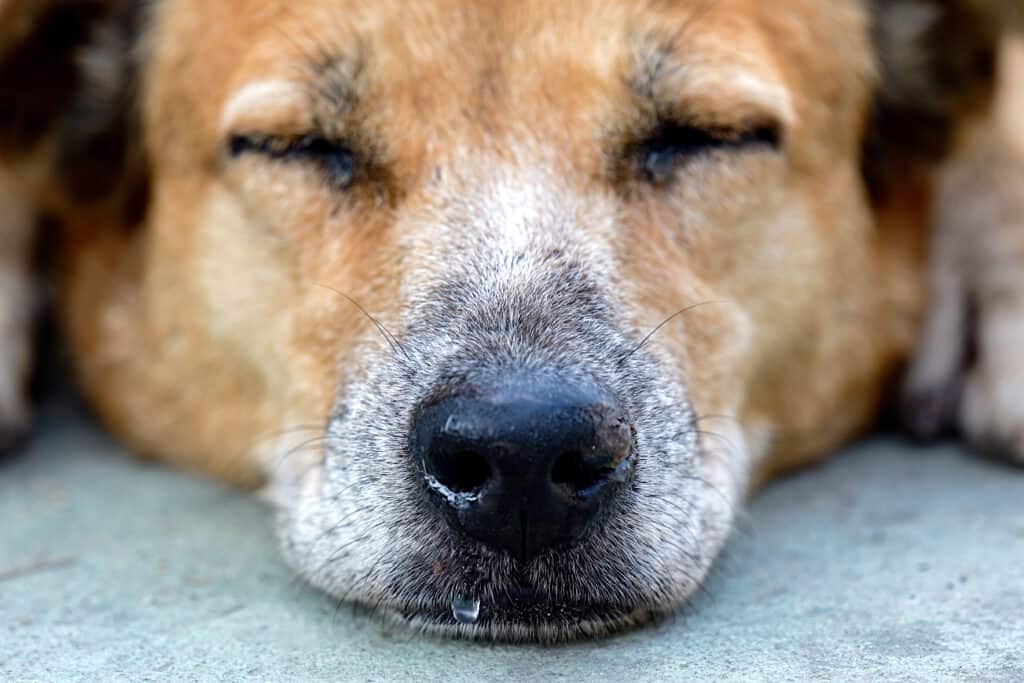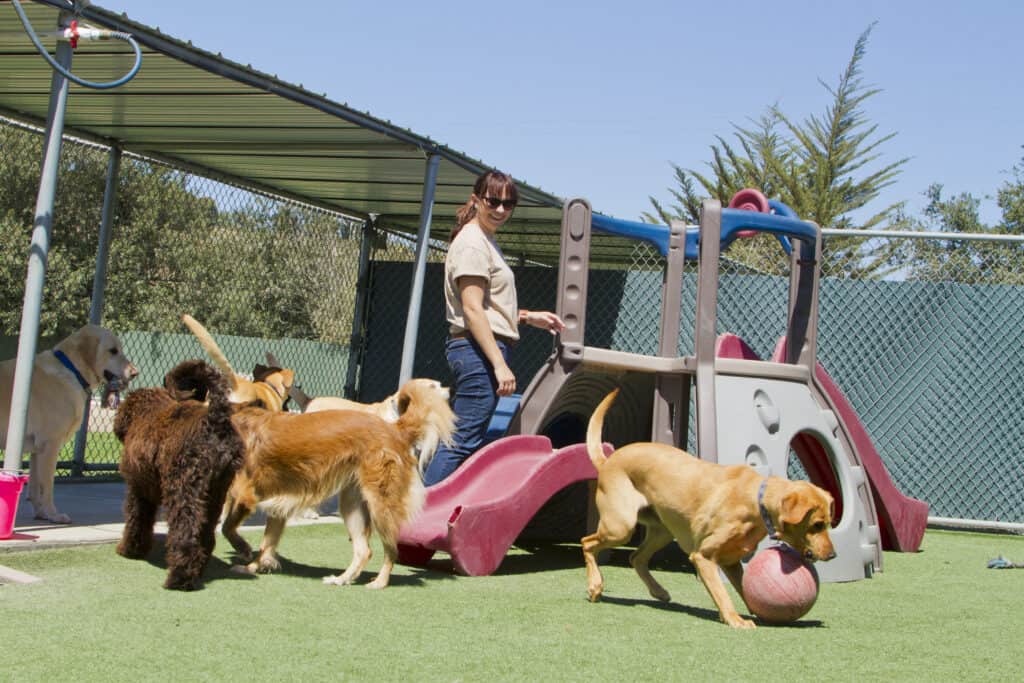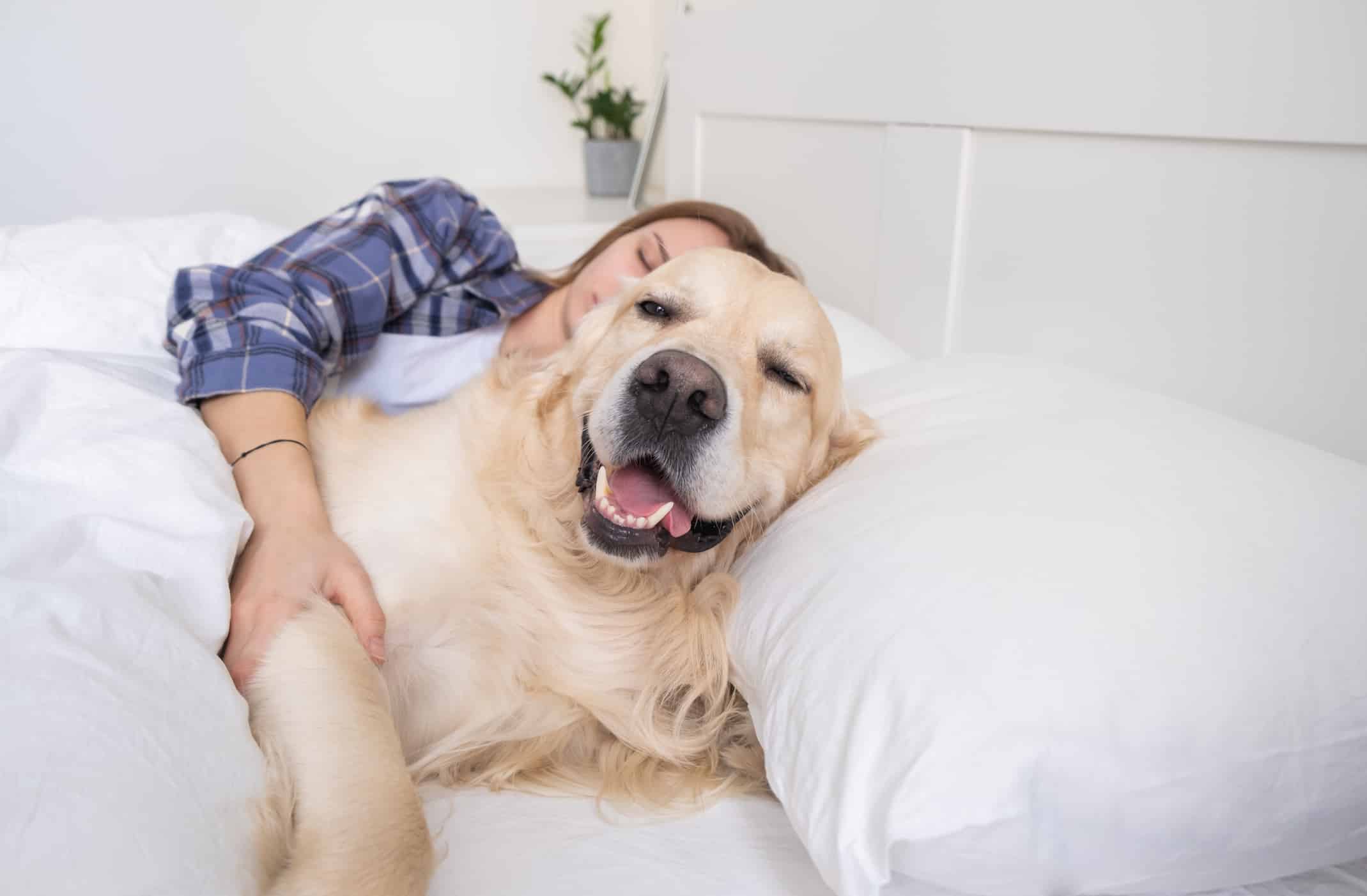Wouldn’t it be nice to take a peep inside your dog’s head? Dogs are unable to lay on a therapist’s couch and discuss their dreams and dissect their meanings. While dogs can’t tell us about their dreams, it is only logical to think that dogs can dream. Scientific evidence even suggests that dogs do dream, despite the fact that it is hard to obtain a first-hand description of their dreams. However, scientists have found ways to interpret what dogs might be dreaming about.
In this article, we’ll explore whether or not dogs actually dream the same way humans do, what they dream about, and more. When it comes down to it, humans and dogs really aren’t that different when it comes to dreams!
Do Dogs Dream?
Yes, dogs can dream. Dogs sleep and dream in a similar way to humans. They experience similar cycles of sleep and can thus dream. And those dreams can be quite vivid!
Dreaming for Dogs vs. Humans
Dreams happen when we sleep. Knowing how we sleep helps us define what dreams are. In both humans and animals, sleep is a natural state of being when consciousness and voluntary muscle activity are decreased. Sleep is crucial for development because it gives the body time to rest and refuel. The brain analyzes memories and events from the previous day as you sleep. While dreams can be highly vivid and appear quite real, you do not truly smell, taste, or feel anything when you are dreaming since you are not fully aware.
Slow Wave Sleep
Human and canine brains both work similarly during sleep and have distinct brain wave patterns throughout the first two stages of the sleep cycle. Slow wave sleep is when you (or your dog) initially fall asleep and your brain waves are sluggish and undulating. The body is not completely relaxed at this point in the sleep cycle because cerebral processes are starting to quiet down but the muscles are still functioning. While your dog will seem to be sleeping soundly, slow wave sleep might quickly rouse them.
Rapid Eye Movement Sleep
Subsequently, a deeper period of sleep with rapid eye movements takes place. This phase of sleep, known as REM sleep, is characterized by rapid and erratic brain waves. In contrast to slow wave sleep, REM sleep involves more relaxed muscles. However, the mind is more alert and the eyes dart quickly under the eyelids. Your dog may start to whimper, breathe quickly, and wiggle their legs during this period of increased brain activity.
Both phases of this sleep cycle are experienced by humans and canines. As both dogs’ and people’s sleeping brains go through comparable phases of electrical activity, it is reasonable to conclude that both humans and dogs can dream in a similar way. Scientific evidence supports this idea by showing that human and canine brain wave patterns are similar. The conclusion is that dreams actually exist in dogs and are a natural element of their sleep cycles.

A sleeping dog (pictured) will exhibit rapid eye movement while in their dream stage.
©Anake Seenadee/Shutterstock.com
How Dog Dreams Work
Dogs do not wake to tell us about their dreams, but via clinical observations, scientists have been able to learn about canine dreams and sleep habits.
A dog’s breathing deepens and becomes more regular as it nods off. For the ordinary dog, dreams typically start after around 20 minutes of REM sleep. The dog may breathe shallowly and erratically while dreaming, and its muscles may jerk. This movement is very noticeable and you might think they are dreaming about chasing cats or rabbits.
Under closed lids, the dog’s eyes move and dart about as though the dog is searching for something. It is thought that much like their owners do during this stage of sleep, dogs visualize dream imagery while they are in REM sleep. In fact, when someone is awakened during the REM sleep stage, they commonly claim to have been right in the middle of dreaming.
The sleeping brain behaves similarly to the awake brain during REM. Both people and dogs dream about events that happened while they were awake. Daytime information is processed at night and can even be revisited in dreams. This is where the pons comes in.
The pons is a region of the brain that prevents you from acting out your dreams physically. You may feel as though you had finished a marathon or jumped out of an airplane after waking up from a dream, but you are really securely in bed. Like its owner, a dog could sleep run while chasing a cat or fetching a ball in their dreams.
What Do Dogs Dream About?
We can probably make a pretty good guess about what our dogs dream about. However, a group of scientists decided to put it to the test. Their specific technique temporarily inhibited the pons so that researchers could determine what dreams dogs could have.
As was already discussed, the pons is the region of the brain stem that regulates deep sleep, controls sleep cycles, and prevents your major muscles from moving while you sleep. You may thus thank the pons for stopping your furry companion from thrashing about and waking you up at night, and vice-versa. Without the pons, we can really carry out all of our dreams, most likely with devastating outcomes.
You may have observed that young puppies and more canines wiggle and twitch a lot as they sleep. The pons is less effective in older dogs and undeveloped in pups, which accounts for this. Infants and elderly people share the same traits.
Researchers discovered that momentarily turning off the pons during REM sleep is one approach to learning what dreams dogs could have. This gave them the opportunity to let the canines live out their dream events under strictly supervised circumstances. Researchers discovered that dogs just have very dog-like dreams. They have dreams that resemble human dreams in that they reflect on their day or on specific memories that need to be processed.
Discovering What Your Dog Is Dreaming About
Although we have no way of knowing for sure, we might be able to make an educated estimate as to what goes into our dogs’ dreams.
Keep an eye on your dog as it sleeps to watch what it does. REM sleep usually starts two to three minutes into a nap and lasts for that amount of time. Your dog may start to twitch or make noises at this point. Are there any parallels between your dog’s REM sleep behaviors and his regular activities?
For instance, one dog may run a lot while it sleeps. Its lips move and its paws twitch constantly. Does it have a target in mind? Playing with a canine companion, perhaps? Maybe it is pursuing an intruder? Or maybe, it is simply chasing its favorite tennis ball over a vast, empty field. If the dog loves doing these things while it is awake, it is very likely that it dreams about these things as well.
Our pets occasionally provide us with even more hints. One owner said in an interview with a Harvard psychologist that he believed his dog had lately experienced a nightmare about taking a bath. This dog detested taking baths; afterward, he would always run to the owner and hide between his legs to avoid it. He never demonstrated this kind of behavior outside of bath time. The owner once witnessed his dog dreaming and exhibiting similar behavior. The dog’s owner assumed that the dog had merely had a terrifying dream about his bath since the dog ran and hid under his knees when it woke up.
To put it simply, use some context clues and you’ll be able to figure out what your pup is dreaming about.

Dogs (pictured) will dream about their days, from playing with other dogs to playing games with their humans.
©Jayme Burrows/Shutterstock.com
Can Dogs Have Nightmares?
It’s heartbreaking to think about, but dogs can have nightmares. As their pets whine or squirm around, some owners might startle their dogs out of a nightmare. Do not be alarmed if you see or hear your dog moan or twitch when it is asleep. There is no need to worry about your dog’s nightly activities, even if they are having a nightmare. Dreams and nightmares alike are simply the brain processing information. Just as well, nightmares in dogs are fairly rare. A typical, healthy occurrence, sleep and wakefulness alternate every 24 hours, and dreaming is a natural aspect of this cycle.
Remember that undisturbed sleep is essential for the physical and mental well-being of both dogs and people. Give your dog a peaceful, cozy place to rest, and leave them be even if it seems like they are having a nightmare. In almost 60% of cases where a child wakes a sleeping dog and is bitten, it is because the child has interrupted an intense dream. It’s crucial to teach kids never to disturb a sleeping dog, even if they seem to be having a bad dream.
How to Tell if a Dog is Dreaming
Dogs frequently growl or jerk their legs while they are dreaming. But occasionally, observing a dog while dreaming might reveal something about its breed. Researchers discovered that a sleeping Springer Spaniel may pursue a dream bird in its dreams, whereas a dreaming Pointer may start searching for prey right away and even go on point. Dog owners who are unsure if their canines are dreaming can just observe them starting 10 to 20 minutes after they go to sleep. They have started dreaming if you can see their eyes moving from beneath their eyelids.
Do Dogs Dream Often?
The frequency and duration of a dog’s dreams vary depending on the dog’s age and size. Some canines dream more frequently than others. Puppy minds, for instance, are more dream-prone than those of adult dogs. Puppies learn a ton of new information every day, and they have a lot of stuff to process while they sleep at night.
Compared to larger breeds, smaller dogs appear to experience dreams more often. According to research, an animal’s size may be associated with the duration and frequency of its dreams. A labrador retriever may only dream once every hour or so, but a Boston terrier may dream every 10 to 15 minutes. A miniature poodle’s dream might only last a minute, but a Mastiff’s dream can last five to 10 minutes. The amount of sleep needed for dogs is also correlated with dream duration and frequency. After a tiring day outside, a larger dog may sleep better and have longer REM sleep periods, which would give them more time to dream.
Ready to discover the top 10 cutest dog breeds in the entire world?
How about the fastest dogs, the largest dogs and those that are -- quite frankly -- just the kindest dogs on the planet? Each day, AZ Animals sends out lists just like this to our thousands of email subscribers. And the best part? It's FREE. Join today by entering your email below.
Thank you for reading! Have some feedback for us? Contact the AZ Animals editorial team.








